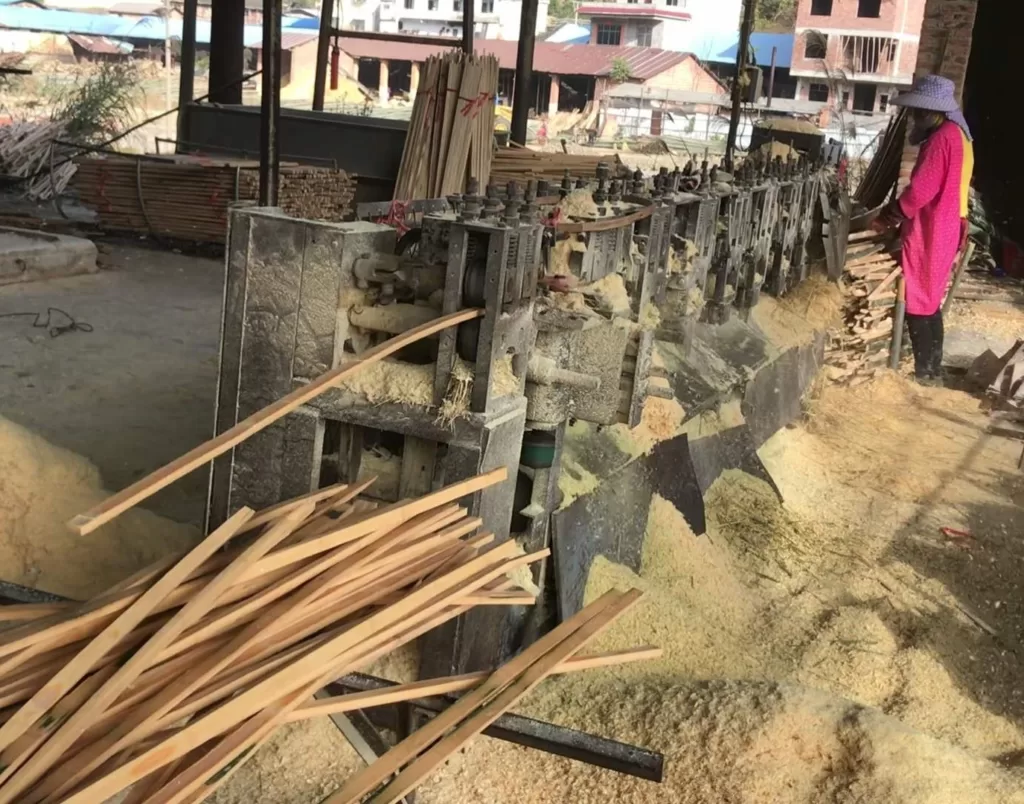
Bamboo Toothbrush production line
The data on global pollution caused by plastic is indeed worrying. According to the data of the United Nations Environment Programme, the world produces about 340 million tons of plastic waste every year. This figure equates to the generation of more than 600 tons of plastic waste every minute. Only about 9 percent of plastic waste is recycled, with the majority (about 79 %) ending up in landfill or incinerated. This results in a massive accumulation of plastic waste and environmental pollution. Plastic waste has a negative impact on the biodiversity, ecological balance and ecological functions of land and water bodies, affecting the reproduction, migration and food chain of species. To mitigate the impact of plastic pollution, it is becoming more and more important to adopt sustainable alternatives such as bamboo toothbrushes, bamboo lids, bamboo combs and other bamboo crafts.
Bamboo is a natural resource that grows fast, is highly renewable, and is common in many regions. Bamboo has antibacterial properties and is less prone to bacteria, making it ideal for toothbrushes. In addition, bamboo itself has a certain degree of toughness and plasticity, and can be processed into the shape of a toothbrush. Bamboo toothbrushes are seen as a sustainable, environmentally friendly and healthy alternative that aims to reduce the use of plastic, reduce plastic pollution and provide consumers with a more sustainable choice.
Located in the beautiful mountains of Yongzhou City, Hunan Province, China, where there are a large number of bamboos, Most of the wild bamboo grows very fast in the middle and top of the mountains, where sunshine and rain give the ideal environment to grow organically, free from chemicals and pesticides.
This is a natural oxygen bar, I like it here.

Had the opportunity to visit the bamboo toothbrush production factory and share the production process with you.
Bamboo toothbrush production process
Processing raw materials – bamboo strips.
Shaping the bamboo Toothbrush handles.
Drilling the hole,Tufting and engraving the bamboo toothbrush
Processing raw materials - bamboo strips.
This method is a raw material processing method for toothbrush bamboo strips, which increases the adhesive force of the product, and at the same time increases the whiteness and brightness of the bamboo slices, according to the different color needs of customers. Deepening the color of the bamboo strips can effectively prevent the bamboo chips from shrinking, cracking and deforming during use, as well as preventing insects and mold
Bamboo production process flow chart

Bamboo material requirements
Bamboo material straight, round, large diameter, use 5–6 years of age
Rough planing
Plane the inner and outer sections of the bamboo slices and the green skin
Carbonization
Soften and degrease the raw materials to prevent mildew and rearrange the internal stress transformation of bamboo fiber, increase the adhesion of the product ,Deepen the color of bamboo slices to meet the needs of customers with different colors.
Carbonization process
Put the stacked bamboo strips into the tank, close the tank door tightly, and put the steam. After the steam enters the tank, the pressure reaches 1KPa, start timing and maintain the pressure, and carbonize for 120min.
Dry
After the carbonized bamboo strips are placed overhead, they are pushed into the baking room for drying, keeping the temperature between 60℃-70℃for one week, and then leaving the baking room, and cooled for 2-3 days.
Carbon recovery
The dried bamboo chips are fully cooled and then sent to the carbonization furnace again for carbonization. After the air pressure reaches 0.8KPa, it is timed and carbonized for 100min
Precision planing-selection
Plan the green skin of the dried bamboo slices, and ensure the requirements of the bamboo slices. Select and reject the bamboo slices that are not qualified for processing.




Storage environment
Cool, dry and ventilated environment. Warehouse temperature controlled at about 20 ~ 25 ℃, and the relative humidity of the air should be 55 ~ 60%.

Shaping the bamboo Toothbrush handles,Drilling the hole,Tufting and engraving the bamboo toothbrush

Selection of raw materials
If it is a Flat handle, please use a bamboo strip with the same thickness as the toothbrush, and the width and length are controlled at: B:-0.00+0.30, L:-0.00+2.00
If it is a Panda handle, the size is controlled at: B&H:-0.00+0.30, L:-0.00+2.00.
Copy the shape
Wood copy shaper machine for copying shapes around, Wood Wave machine for copying upper and lower surfaces.
Surface Treatment
Bamboo toothbrushes can be given a surface treatment such as sanding, painting or painting as desired to enhance the appearance and protect the toothbrush.
Drilling holes
Use Drilling Machine to drill holes in one end of the bamboo brush handle to hold the toothbrush bristles. The diameter and depth of the holes should match the bristles used.
Bristle Fixation and Conditioning
Attach natural bristles such as boar bristles or plant fibers to the bamboo handle. Use Turfting & Tirmming machine to fix the bristles in the hole of the handle, make sure the bristles are firmly in place, and trim the length and shape of the bristles to make them uniform and meet the requirements of people using toothbrushes.
Quality check
Quality checks are carried out on manufactured bamboo toothbrushes to ensure that the handle and bristles are well held and that there are no visible defects or blemishes.
Packaging and Shipping
Bamboo toothbrushes are packaged and ready to be shipped to retailers or sold directly to consumers.
The specific process of making a bamboo toothbrush may vary by manufacturer and process, it is for reference only
Share To: